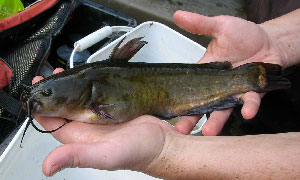Brown Bullhead
Ameiurus nebulosus
 Distribution: The brown bullhead is native to eastern North America from Saskatchewan east to New Brunswick and south to Louisiana. Brown bullheads are common in Atlantic and Gulf coast drainages, but they have a more patchy distribution in the Mississippi drainage. They have been widely introduced outside their native range. They are found throughout New Hampshire.
Distribution: The brown bullhead is native to eastern North America from Saskatchewan east to New Brunswick and south to Louisiana. Brown bullheads are common in Atlantic and Gulf coast drainages, but they have a more patchy distribution in the Mississippi drainage. They have been widely introduced outside their native range. They are found throughout New Hampshire.
Description: The brown bullhead, also known as horned pout, is a dark gray to brown colored catfish with a cream-colored belly. Its dark colored whiskers distinguish the brown bullhead from its close relative, the yellow bullhead, which gets its name from its yellowish underbelly and bottom two whiskers. Juvenile brown bullheads may be distinguished from margined madtoms by their prominent adipose fin. The adipose fin of the madtom is fused to the caudal fin.
Species commonly confused with: Yellow bullhead, margined madtom
Habitat: The brown bullhead prefers lakes, ponds, and slow moving sections of rivers and streams. However, brown bullheads are widespread throughout New Hampshire and may be found in almost any habitat, including faster flowing streams with rocky substrate.

Life History: Brown bullheads spawn in late spring when water temperature exceeds 65°F. Eggs are deposited in small depressions excavated in the sand in shallow water, usually near shelter such as an overhanging bank or fallen tree. Both parents tend the nest by aerating the gelatinous eggs with their fins and occasionally ingesting them into their mouths. Once hatched, the juveniles will follow the adults in a compact school for several weeks. It takes three years for a brown bullhead to reach maturity. Adults usually range between 6 and 15 inches, but some individuals may reach 18 inches and weigh up to 4 pounds.
Brown bullheads are extremely resilient and can tolerate dissolved oxygen levels of less than 1 part per million. For this reason, they are not a good indicator of water quality. The brown bullhead survives in low oxygen conditions by gulping air into its air bladder and breathing through its skin. It may lie dormant for days in the mud of a dried up pond or stream.
Origin: Native
Conservation/Management: There are no specific management recommendations for brown bullhead.



